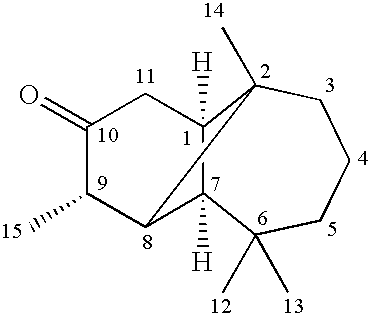Fragrance material
- Summary
- Abstract
- Description
- Claims
- Application Information
AI Technical Summary
Benefits of technology
Problems solved by technology
Method used
Image
Examples
example i
Enrichment and Isolation of the Compound of the Invention and the C-9 Epimer from Juniperus chinensis var. torulosa Heartwood
[0050]In 1.3-kg batches, chipped and ground Juniperus chinensis var. torulosa heartwood (9 kg total) was extracted by covering the wood with n-hexane for 24 hrs in a large glass column, draining off the solution, and then repeating the extraction a second time. The total yield of crude oil was 515 g after solvent removal. The crude oil was hydrodistilled in 103-g batches for three days from 800 ml of an aqueous solution of 240 g sodium chloride and 10 g of sodium bicarbonate, with 20 ml of n-hexane in the receiver and continuous return of condensed water to the distillation flask. A total yield of 450 g of pale yellow oil was obtained after solvent removal.
[0051]This hydrodistilled oil was separated by normal-phase LC of 30-g batches, using these conditions: 1200 g silica gel adsorbent (−200 mesh); eluent step gradients of increasing percentages of ethyl aceta...
example ii
Preparation of the Material of the Invention by Subjecting (1R,2S,7R,8R,9R)-2,6,6,9-tetramethyltricyclo[5.4.0.02,8]undecan-10-one to Keto-Enol Tautomerization
[0062]1 mg of (1R,2S,7R,8R,9R)-2,6,6,9-tetramethyltricyclo-[5.4.0.02,8]-undecan-10-one (i.e. the C-9 epimer of Example I) was dissolved in 0.8 ml of ethanol and the solution divided equally into four screw cap vials. To each vial was added 0.75 ml of 10−4 M aqueous potassium hydroxide, after which the capped vials were placed in a 100° C. oven. After selected intervals, a vial was withdrawn and the solution extracted twice with n-hexane. The hexane extracts were analyzed by dual-column GC and enantioselective GC, giving the following percentages of Reactant and Product, the latter being the compound of the invention.
[0063]
Time (hr)Reactant (%)Product (%)010001821234159181783421486
[0064]The isomerization reaction thus provides useful grades of the material of the invention comprising the compound of the invention at concentratio...
example iii
Preparation of the Compound of the Invention from (+)-alpha-longipinene
[0065]All reactions were carried out at 25° C. In a sealed septum vial, 225 mg of (+)-α-longipinene (IUPAC name (1R,2S,7R,8R)-2,6,6,9-tetramethyltricyclo[5.4.0.02,8]undec-9-ene) were added to a solution of 30 mg of lithium borohydride in 0.8 ml dry ethyl ether. A solution of 40 microliters of boron trifluoride etherate in 120 microliters of dry ethyl ether was injected through the septum over the course of 15 minutes. After a further 2 hours, excess borohydride was destroyed by addition of 0.15 ml of water.
[0066]A solution of 0.26 g of potassium dichromate and 0.37 g of sulfuric acid in 1.1 ml water was added to the reaction mixture over the course of 15 minutes. After holding for 90 minutes with occasional shaking, the upper ether layer was withdrawn and the aqueous layer extracted several times with 0.5 ml ethyl ether. The combined ether extracts were washed with aqueous sodium bicarbonate, then with water, dri...
PUM
| Property | Measurement | Unit |
|---|---|---|
| Percent by mass | aaaaa | aaaaa |
| Percent by mass | aaaaa | aaaaa |
| Percent by mass | aaaaa | aaaaa |
Abstract
Description
Claims
Application Information
 Login to View More
Login to View More - R&D
- Intellectual Property
- Life Sciences
- Materials
- Tech Scout
- Unparalleled Data Quality
- Higher Quality Content
- 60% Fewer Hallucinations
Browse by: Latest US Patents, China's latest patents, Technical Efficacy Thesaurus, Application Domain, Technology Topic, Popular Technical Reports.
© 2025 PatSnap. All rights reserved.Legal|Privacy policy|Modern Slavery Act Transparency Statement|Sitemap|About US| Contact US: help@patsnap.com



